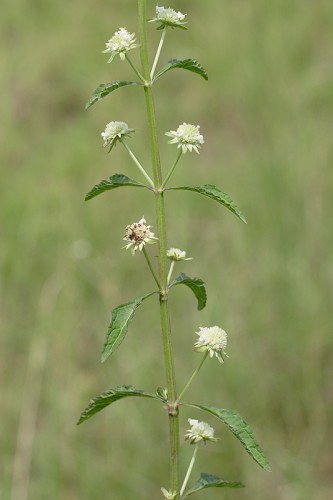Hyptis alata
Common names: cluster bushmint[1] , musky mint[2]
| Hyptis alata | |
|---|---|

| |
| Photo by the Southeastern Flora Plant Database | |
| Scientific classification | |
| Kingdom: | Plantae |
| Division: | Magnoliophyta - Flowering plants |
| Class: | Magnoliopsida - Dicots |
| Order: | Lamiales |
| Family: | Lamiaceae |
| Genus: | Hyptis |
| Species: | H. alata |
| Binomial name | |
| Hyptis alata Raf. | |

| |
| Natural range of Hyptis alata from USDA NRCS Plants Database. | |
Contents
Taxonomic Notes
Synonyms: H. radiata Willdenow.[3]
Varieties: none.[3]
Description
H. alata is a perennial forb/herb of the Lamiaceae family that is native to North America.[1] It can grow up to 4 feet tall with round flower heads and individual flowers spotted with purple. Leaves are simple, oppositely arranged, lanceolate, and with serrated leaf margins. As well, its common name comes from the musky mint odor the plant gives off.[4]
Distribution
H. alata is found in Florida, Georgia, South Carolina, North Carolina, Alabama, Mississippi, Louisiana, and Texas in the southeastern United States.[1] It is also native to the West Indies.[5]
Ecology
Habitat
H. alata is commonly found in wet pine savannas, edges of swamp forests, and moist ditches.[5] Additionally, habitats that specimens of H. alata have been recovered from include pine flatwoods, in sandy peat of swampland, burned pineland, cypress dome, wet sandy loam, and coastal hammock.[6] This species can grow in full sun and part shade, moist to wet sandy soils, acidic to circumneutral soil pH, and is cold and heat tolerant.[4] It is listed by the USDA Natural Resources Conservation Service as an obligate wetland species that is almost exclusively found in wetland habitats.[1] As well, it is considered to be an indicator species of the calcareous savanna habitats in Florida.[7] In terms of disturbances, this species was shown to be negatively affected by clearcutting the overstory.[8]
Associated species include Magnolia grandiflora, Celtis sp., Tilia sp., Jacquemontia sp., Stachys sp., Polygonum sp., and others.[6]
Hyptis alata is an indicator species for the Calcareous Savannas community type as described in Carr et al. (2010).[9]
Phenology
Generally, H. alata flowers from late June until September.[5] It has been observed to flower in June, July, September, and October.[10]
Seed bank and germination
Seeds of Hyptis alata have been found to persist in the seed bank even after a fire disturbance.[11]
Fire ecology
This species has been observed in habitats that have fire disturbance.[6] As well, even the seeds of this species were found to persist in the seed bank following a fire disturbance.[11]
Herbivory and toxicology
This species attracts bees, birds, and butterflies, and is moderately deer resistant.[4] It is considered to be of poor forage value.[12]
Conservation, cultivation, and restoration
Hyptis alata is considered a vulnerable species in the state of North Carolina.[13]
Cultural use
Photo Gallery
References and notes
- ↑ 1.0 1.1 1.2 1.3 USDA Plant Database
- ↑ Kalmbacher, R. S., et al. (1994). "South Florida flatwoods range vegetation responses to season of deferment from grazing." Journal of Range Management 47(1): 43-47.
- ↑ 3.0 3.1 Weakley, A.S. 2015. Flora of the southern and mid-atlantic states. Working Draft of 21 May 2015. University of North Carolina at Chapel Hill, Chapel Hill, North Carolina.
- ↑ 4.0 4.1 4.2 [[1]] Lady Bird Johnson Wildflower Center. Accessed: May 30, 2019
- ↑ 5.0 5.1 5.2 Weakley, A. S. (2015). Flora of the Southern and Mid-Atlantic States. Chapel Hill, NC, University of North Carolina Herbarium.
- ↑ 6.0 6.1 6.2 URL: http://herbarium.bio.fsu.edu. Last accessed: June 2018. Collectors: R.K. Godfrey, R. Kral, Samuel B. Jones, Jr., Karen MacClendon, Gary R. Knight, Loran C. Anderson. States and counties: Florida (Charlotte, Brevard, Calhoun, Jackson, Franklin), Mississippi (Lamar)
- ↑ Carr, S. C., et al. (2010). "A Vegetation Classification of Fire-Dependent Pinelands of Florida." Castanea 75(2): 153-189.
- ↑ Brockway, D. G. and C. E. Lewis (2003). "Influence of deer, cattle grazing and timber harvest on plant species diversity in a longleaf pine bluestem ecosystem." Forest Ecology and Management 175: 49-69.
- ↑ Carr, S.C., K.M. Robertson, and R.K. Peet. 2010. A vegetation classification of fire-dependent pinelands of Florida. Castanea 75:153-189.
- ↑ Nelson, G. PanFlora: Plant data for the eastern United States with emphasis on the Southeastern Coastal Plains, Florida, and the Florida Panhandle. www.gilnelson.com/PanFlora/ Accessed: 22 MAY 2018
- ↑ 11.0 11.1 Kalmbacher, R., et al. (2005). "Seeds obtained by vacuuming the soil surface after fire compared with soil seedbank in a flatwoods plant community." Native Plants Journal 6: 233-241.
- ↑ Hilman, J. B. (1964). "Plants of the Caloosa Experimental Range " U.S. Forest Service Research Paper SE-12
- ↑ [[2]] NatureServe Explorer. Accessed: May 30, 2019